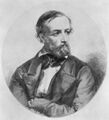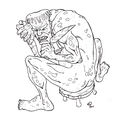Template:Selected anniversaries/July 27: Difference between revisions
No edit summary |
No edit summary |
||
| Line 1: | Line 1: | ||
<gallery> | <gallery> | ||
||1667 | ||1667: Johann Bernoulli born ... mathematician and academic. | ||
||1733 | ||1733: Jeremiah Dixon born ... surveyor and astronomer. | ||
||1759 | ||1759: Pierre Louis Maupertuis dies ... mathematician and philosopher. | ||
||1775 | ||1775: Founding of the U.S. Army Medical Department: The Second Continental Congress passes legislation establishing "an hospital for an army consisting of 20,000 men." | ||
||Heinrich Wilhelm Brandes | ||1777: Heinrich Wilhelm Brandes born ... physicist, meteorologist, and astronomer. | ||
File:George Biddell Airy 1891.jpg|link=George Biddell Airy (nonfiction)|1801: Mathematician and astronomer [[George Biddell Airy (nonfiction)|George Biddell Airy]] born. His achievements will include work on planetary orbits, measuring the mean density of the Earth, and, in his role as Astronomer Royal, establishing Greenwich as the location of the prime meridian. | File:George Biddell Airy 1891.jpg|link=George Biddell Airy (nonfiction)|1801: Mathematician and astronomer [[George Biddell Airy (nonfiction)|George Biddell Airy]] born. His achievements will include work on planetary orbits, measuring the mean density of the Earth, and, in his role as Astronomer Royal, establishing Greenwich as the location of the prime meridian. | ||
| Line 16: | Line 16: | ||
File:John Dalton by Charles Turner.jpg|link=John Dalton (nonfiction)|1844: Chemist, meteorologist, and physicist [[John Dalton (nonfiction)|John Dalton]] dies. He proposed the modern atomic theory, and did research in color blindness. | File:John Dalton by Charles Turner.jpg|link=John Dalton (nonfiction)|1844: Chemist, meteorologist, and physicist [[John Dalton (nonfiction)|John Dalton]] dies. He proposed the modern atomic theory, and did research in color blindness. | ||
||1848 | ||1848: Loránd Eötvös born ... physicist and politician, Minister of Education of Hungary. | ||
||1849: John Hopkinson born ... physicist and electrical engineer who worked on the application of electricity and magnetism in devices like the dynamo and electromagnets. Hopkinson's law (the magnetic equivalent of Ohm's law) bears his name. In 1882, he patented his invention of the three-wire system (three phase) for electricity generation and distribution. He presented the principle the synchronous motors (1883), and designed electric generators with better efficiency. He also studied condensers and the phenomena of residual load. In his earlier career, he became (1872) engineering manager of Chance Brothers and Co., a glass manufacturer in Birmingham, where he studied lighthouse illumination, improving efficiency with flashing groups of lights. Pic: https://es.wikipedia.org/wiki/John_Hopkinson | |||
||1866 – The first permanent transatlantic telegraph cable is successfully completed, stretching from Valentia Island, Ireland, to Heart's Content, Newfoundland. | ||1866 – The first permanent transatlantic telegraph cable is successfully completed, stretching from Valentia Island, Ireland, to Heart's Content, Newfoundland. | ||
Revision as of 09:56, 26 August 2018
1801: Mathematician and astronomer George Biddell Airy born. His achievements will include work on planetary orbits, measuring the mean density of the Earth, and, in his role as Astronomer Royal, establishing Greenwich as the location of the prime meridian.
1837: Peter Dirichlet presented his first analytic number theory paper at a meeting of the Berlin Academy of Sciences. He proved the fundamental theorem that bears his name: Every arithmetical sequence an + b, n = 0, 1, 2, ... of integers, where a and b are relatively prime, contains infinitely many primes.
1844: Chemist, meteorologist, and physicist John Dalton dies. He proposed the modern atomic theory, and did research in color blindness.
1871: Logician and mathematician Ernst Friedrich Ferdinand Zermelo born. His work will have major implications for the foundations of mathematics; he will be known for his role in developing Zermelo–Fraenkel axiomatic set theory, and for his proof of the well-ordering theorem.
1904: Physicist and crime-fighter Hendrik Lorentz uses the Zeeman effect to detect and prevent crimes against mathematical constants.
1928: Electrical engineer and physicist John Ambrose Fleming marries the popular young singer Olive May Franks of Bristol.
1938: Mathematician and philosopher Edmund Husserl publishes new class of Gnomon algorithm functions based on transcendental consciousness as the limit of all possible knowledge.
1938: Game designer Gary Gygax born.
1973: Math photographer Cantor Parabola takes advance photographs of the House of Representatives Judiciary Committee voting to recommend the first article of impeachment against President Nixon.
1974: Watergate scandal (nonfiction): The House of Representatives Judiciary Committee votes 27 to 11 to recommend the first article of impeachment (for obstruction of justice) against President Richard Nixon.
1974: Writer and philosopher Culvert Origenes says that "it's about time the House Judiciary Committee got busy impeaching Nixon."










